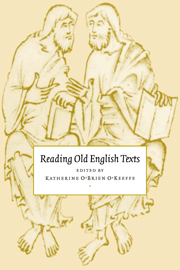Book contents
- Frontmatter
- Contents
- List of contributors
- List of abbreviations
- Note on the text
- Introduction
- 1 The comparative approach
- 2 Source study
- 3 Language matters
- 4 Historicist approaches
- 5 Oral tradition
- 6 The recovery of texts
- 7 At a crossroads: Old English and feminist criticism
- 8 Post-structuralist theories: the subject and the text
- 9 Old English and computing: a guided tour
- Suggestions for further reading
- Index
6 - The recovery of texts
Published online by Cambridge University Press: 18 December 2009
- Frontmatter
- Contents
- List of contributors
- List of abbreviations
- Note on the text
- Introduction
- 1 The comparative approach
- 2 Source study
- 3 Language matters
- 4 Historicist approaches
- 5 Oral tradition
- 6 The recovery of texts
- 7 At a crossroads: Old English and feminist criticism
- 8 Post-structuralist theories: the subject and the text
- 9 Old English and computing: a guided tour
- Suggestions for further reading
- Index
Summary
Et verbum caro factum est.
(John 1:14)When the Fourth Gospel-Writer began his account with brilliant, Neoplatonic imagery, implying many related philosophical ideas about the origin of things, his interest was hardly textual criticism. Rather, the writer known as John sought to give expression to a recurrent Neoplatonic theme that eventually was woven into the recovery of texts from originary manuscript evidence: just as the divine had entered the corporeal world, so too had the words of authors descended from some special, irradiated literary sphere onto and into the flesh of animal skins, and just as the soul had entered the mundane, becoming corrupted and contaminated in the woeful descent, so too had the words of authors become corrupted and contaminated by successive transmission from archetype or exemplar, often but dimly perceived, to copy most sullied. The daemons in the transmission of text are most clearly the scribes who wound and torture words and texts in this Fall, and the redeemers most clearly are the editors who seek to restore readings to their original state. The process of restoration needed both theory and method beyond mere suppressed imagery, of course, and it was the nineteenth century, building upon its predecessors, that set about the task of ascertaining the author's words by methods that were positivist, scientific, and verifiable. Thus, generations before literary criticism became ‘theoretical’, i.e. self-conscious and reflective of its aims, methods, and presuppositions, textual criticism could be most theoretical indeed, especially in the recovery of Holy Writ or ancient texts.
- Type
- Chapter
- Information
- Reading Old English Texts , pp. 124 - 145Publisher: Cambridge University PressPrint publication year: 1997
- 1
- Cited by



